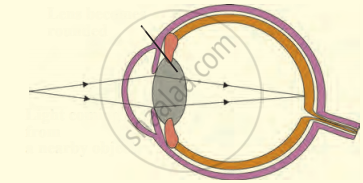Advertisements
Advertisements
प्रश्न
With reference to human eye answer the question that follow:
Name the part of the eye associated with the regulation of the shape of lens.
उत्तर
Ciliary Muscles
संबंधित प्रश्न
Draw labelled diagrams of the following: Eye
The size of the pupil becomes ______ when you see in dim light.
What is the function of the lens in the human eye?
What changes the shape of lens in the eye?
What is the:
near point of a normal human eye?
Fill in the following blank with suitable word:
The part of eye sensitive to light is...................
Fill in the following blank with suitable words:
When light is dim, the pupil becomes................
What changes take place in the shape of eye-lens:
when the eye is focused on a distant object?
The eyes of a person are focused (i) on a nearby object, and (ii) on a distant object, turn by turn. In which case:
the focal length of eye-lens will be the maximum?
Which parts of the eye cause rays of light to converge on the retina?
Why does the eye-lens not have to do all the work of converging incoming light rays?
State whether the following statement is true or false:
Rabbit has eyes which look sideways.
Five persons A, B, C, D and E have diabetes, leukaemia, asthma, meningitis and hepatitis, respectively.
Which of these persons can donate eyes?
The figure below compares a part of our eye with a part of a photographic camera.

Name the corresponding parts of the eye the camera shown here that are comparable in function.
Name the following:
Yellow spot and ciliary muscles are found in.
Give Technical Term:
The cells of the retina that are sensitive to colour.
Name the capacity of the eye lens to change its focal length as per need.
The following figure show the change in the shape of the lens while seeing distant and nearby objects. Complete the figures by correctly labelling the diagram.

From where the following nerves arise.
Optic nerve
Match the following:
| Column - I | Column - II |
| 1. Retina | a) Path way of light |
| 2. Pupil | b) Far point comes closer |
| 3. Ciliary muscles | c) near point moves away |
| 4. Myopia | d) Screen of the eye |
| 5. Hypermetropia | e) Power of accommodation |
